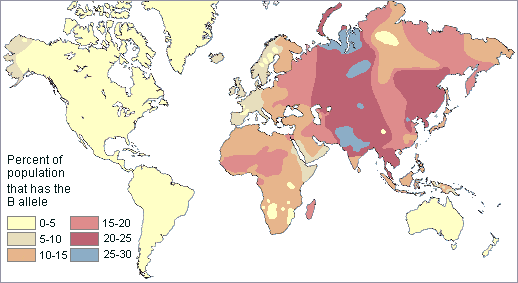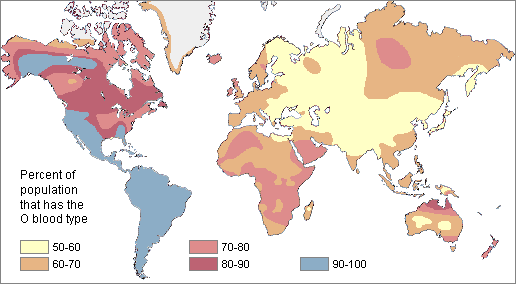The Anthropology Tutorials website will be taken offline on January 9, 2026.
Due to federal accessibility requirements taking effect in 2026, we will be removing this site. If you use materials from this site in your courses or research, please seek alternative resources.
Distribution
of Blood Types
Blood
provides an ideal opportunity for the study of human variation without
cultural prejudice. It
can be easily classified for many different genetically inherited blood typing systems.
Also significant is the fact that we rarely take blood types into consideration in
selecting mates. In addition, few people know their own type today and no one did
prior to 1900. As a result, differences in blood type frequencies around the world are
most likely due to other factors than social discrimination.
Contemporary Japan is somewhat of an exception since there are popular
Japanese stereotypes about people with different blood types.
This could affect choice in marriage partners for some Japanese.
All human
populations share the same 29 known blood systems, although they differ in the frequencies of
specific types. Given the evolutionary closeness of apes and monkeys to our species,
it is not surprising that some of them share a number of blood typing systems with us as
well.
When we
donate blood or have surgery, a small sample is usually taken in advance for at least ABO
 and Rh
and Rh
 systems typing. If you are O+, the O is your ABO type and the + is
your Rh type. It is possible to be A, B, AB, or O as well as Rh+
systems typing. If you are O+, the O is your ABO type and the + is
your Rh type. It is possible to be A, B, AB, or O as well as Rh+
 or Rh-
or Rh-
 .
You inherited your blood types from your parents and the environment in which you live cannot
change them.
.
You inherited your blood types from your parents and the environment in which you live cannot
change them.
ABO Blood Type System
We have learned a good deal
about how common each of the ABO blood types is around the world. It is
quite clear that the distribution patterns are complex. Both clinal and
discontinuous distributions
exist, suggesting a complicated evolutionary history for humanity. This can be seen with
the global frequency patterns of the type B blood allele (shown in the map
below). Note that it is highest in
Central Asia and lowest among the
indigenous peoples of the Americas and Australia. However, there are
relatively high frequency pockets in Africa as well. Overall in the
world, B is the rarest ABO blood allele.
Only 16% of humanity have it.
 |
| Distribution of the
B type blood
allele in native populations of the world |
The
A
blood allele is somewhat more common
around the world than B.
About 21% of all people share the A allele.
The highest frequencies of A are found in small, unrelated populations, especially
the Blackfoot Indians of Montana (30-35%), the Australian Aborigines (many
groups are
40-53%), and the Lapps, or Saami people, of Northern Scandinavia (50-90%). The A allele
apparently was absent among Central and South American Indians.
|

|
| Distribution of the
A type blood
allele in native populations of the world |
The O
blood type (usually resulting from the absence of both A
and B alleles) is very common around the world.
About 63% of humans share it. Type
O is particularly high in frequency among the indigenous populations of Central
and South America, where it approaches 100%. It
also is relatively high among Australian Aborigines and in Western Europe
(especially in populations with Celtic ancestors). The lowest frequency
of O
is found in Eastern Europe and Central Asia, where B is
common.
 |
| Distribution of the
O type blood
in native populations of the world |
Other Blood Type Systems
The
majority of the people in the world have the Rh+ blood type. However, it is
more common in some regions. Native Americans and Australian Aborigines
were very likely 99-100% Rh+
before they began interbreeding with people from other parts of the world.
This does not imply that Native Americans and Australian Aborigines are
historically closely related to each other. Most Subsaharan
African populations are around 97-99%
Rh+. East Asians are 93-99+% Rh+.
Europeans have the lowest frequency of this blood type for any continent.
They are 83-85% Rh+.
The lowest known frequency is found among the Basques of the Pyrenees
Mountains between France and Spain. They are only 65%
Rh+.
The distribution
patterns for the Diego
 blood system are even more striking. Evidently, all
Africans, Europeans, East Indians, Australian Aborigines, and Polynesians are
Diego negative. The only populations with
Diego positive people may be Native Americans (2-46%) and East Asians (3-12%).
This nonrandom distribution pattern fits well with the hypothesis of an East
Asian origin for Native Americans.
blood system are even more striking. Evidently, all
Africans, Europeans, East Indians, Australian Aborigines, and Polynesians are
Diego negative. The only populations with
Diego positive people may be Native Americans (2-46%) and East Asians (3-12%).
This nonrandom distribution pattern fits well with the hypothesis of an East
Asian origin for Native Americans.
Conclusion
These patterns of
ABO, Rh, and Diego blood type distributions are not similar to those for skin color or other so-called
"racial" traits. The implication is that the specific causes responsible
for the distribution of human blood types have been different than those for other traits
that have been commonly employed to categorize people into "races." Since
it would be possible to divide up humanity into radically different groupings using blood
typing instead of other genetically inherited traits such as skin color, we have more
conclusive evidence that the commonly used typological
model for understanding human variation is scientifically unsound.
The more we study the
precise details of human variation, the more we understand how complex are the
patterns. They cannot be easily summarized or understood. Yet, this
hard-earned scientific knowledge is generally ignored in
most countries because of more demanding social and
political concerns. As a result, discrimination based on presumed "racial"
groups still continues. It is important to keep in
mind that this "racial" classification often has more to do with cultural
and historical distinctions than it does with biology. In a very real
sense, "race" is a distinction that is created by culture not biology.
Copyright 1998-2012 by Dennis
O'Neil. All
rights reserved.
illustration
credits
![]() and Rh
and Rh
![]() systems typing. If you are O+, the O is your ABO type and the + is
your Rh type. It is possible to be A, B, AB, or O as well as Rh+
systems typing. If you are O+, the O is your ABO type and the + is
your Rh type. It is possible to be A, B, AB, or O as well as Rh+
![]() or Rh-
or Rh-
![]() .
You inherited your blood types from your parents and the environment in which you live cannot
change them.
.
You inherited your blood types from your parents and the environment in which you live cannot
change them.

